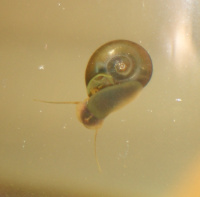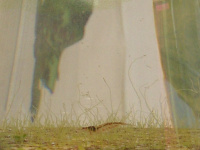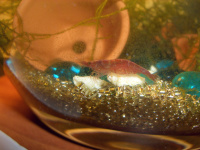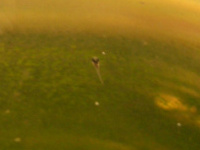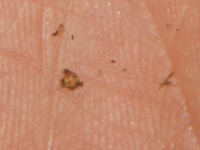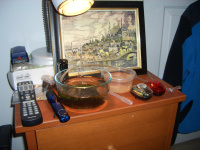-Self Sustaining Fishtank

This fishtank began as an idea years ago when I first became interested in aquariums and self contained ecosystems. I admit, this isn't entirely self contained, but this fishtank is designed to keep itself going given light, air, and the occasional top off of water.
This page and the former fishtank page are organized like a journal, as it has had several successive changes and will continue to change as needed until it is stable. This is a project and an experiment.
Another attempt with fish
I decided, after having a few shrimp and plants going for some time on their own, that I would give fish another try. To reduce the negative impact of the fish (Nitrates in the water which kill the shrimp in an unfiltered environment), I decided to go with fewer fish and somewhat smaller ones, opting for Killie Fish. Killies are colorful hardy fish which come in many varieties and from many places, they often lay eggs which incubate while dry, out of the water, and hatch when submerged again. I did some research and ordered 50 eggs of a nice variety off of eBay.
When the eggs were on their way, I went about putting together a tank to hatch the fries(baby fish) in. I ended up getting a Pyrex bowl from the grocery store, then filled it with tank and aged tap water. I put in a couple of snails from the main tank and a bit of a plant, then attached my old bubbler for some aeration. I let this tank run for a little bit to get stabilized before dumping in the eggs and peat to hatch the fish.
The first hatch attempt was unsuccessful. Though the eggs were marked to hatch starting on the day I received them, they did nothing when submerged in properly aerated water. After closer inspection, I could see very few of the telltale irises in the eggs so I figured they needed more dry incubation time. After waiting about a week, I restarted the tank and waited for good news. After a few days I got 2 fries (baby fish) and after some raising time in the hatchery tank, I moved them to the aquarium. For whatever reason, I haven't seen them since. Neither of the fries (which may have been belly sliders based on their behavior) lasted long enough to grow in the main tank, even though the water conditions were very similar.
In a final attempt I got no results, and after not seeing the fries from the previous attempt I gave up on the project. Out of 50 eggs I had 2 hatches, and no survivors, and I'm not exactly sure what went wrong. I suspect the eggs did not arrive in the best condition, as I followed all of the directions and tried out all the techniques I could find for hatching more fries.
Remodeling
With the fish experiments failed and the java moss slowly making a jungle in the bottom of the tank, I decided it needed some remodeling. I knew I wanted something to give the bottom of the tank a little bit of height and interest, but wasn't sure what. On a trip to the grocery store I stopped by a craft store and found a bunch of things I was looking for. I got a couple of miniature terracotta pots for decorations in the bottom, some small sea shell beads (I had suspected that with snails, shrimp, and fairly soft water, that a little extra dissolved calcium would help), and some small glass beads which turned out to make a much better substrate than what I had.
I broke up one of the pots and soaked everything before dropping it in the tank. I then trimmed the java moss to be about half the size, and started arranging things. The new clear glass beads make a much better substrate for the clams to dig through, and provide decent water circulation and surface area for bacteria because of the hole through the middle. Since they are clear glass, they even lightened up the color of the bottom of the tank. The terracotta pots provide some hiding places and anchoring points for plants, and will gradually become covered with algae, making them look very aged and giving the shrimp something different to snack/walk on. The shell beads are scattered around to slowly dissolve and provide some of the nutrients important to invertebrates.
With the new look to the tank, I just have to let everything settle in a bit and wait for the shrimp to start to multiply. I have 3 currently and want more (I know the tank can support them) but am hesitant to buy additional ones for at least a little while.
More Shrimp and Growth
I ended up buying more shrimp to add in to the tank. With the new shrimp the population is quite stable and they're very active. The snails began to multiply and cover the plants at the bottom while some duckweed from the shipment of shrimp covered the top.
The excessive snail growth became a problem and I started removing them on a daily basis and keeping them in a small secondary tank without real use for them. There's still tons in the tank, but they're not quite as pervasive. I also took out some java moss and shrimp to start a new smaller tank. I'm just waiting on another plant and some fancier Asolene Spixi snails to move them into the new tank.
With the snail population more under control and a new tank beginning, the larger tank is aging quite well. All of the larger blue glass stones in the bottom have risen to the top thanks to the continuous churning of the substrate by the clams. The plants have also taken hold at the bottom of the tank without exploding throughout it, and the shrimp do a great job keeping everything fairly debris free. The terracotta pots are beginning to be encrusted with algae, contributing to the natural look of the aquarium.
Fishtank Gallery:
The previous Fishtank page


5/28/08



